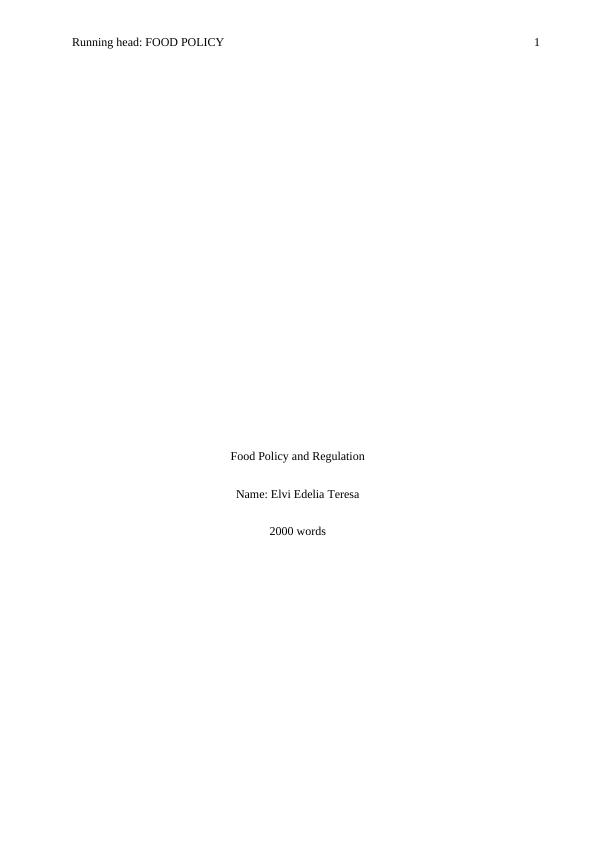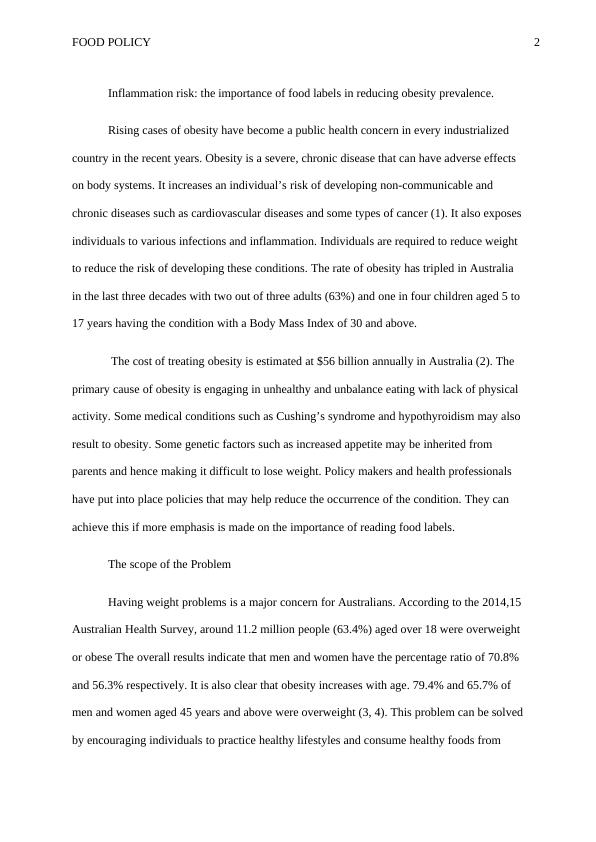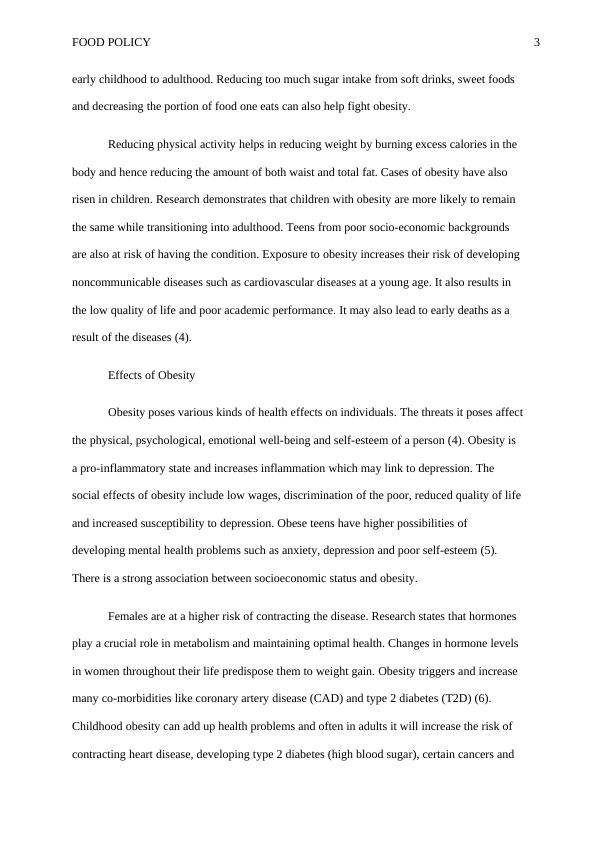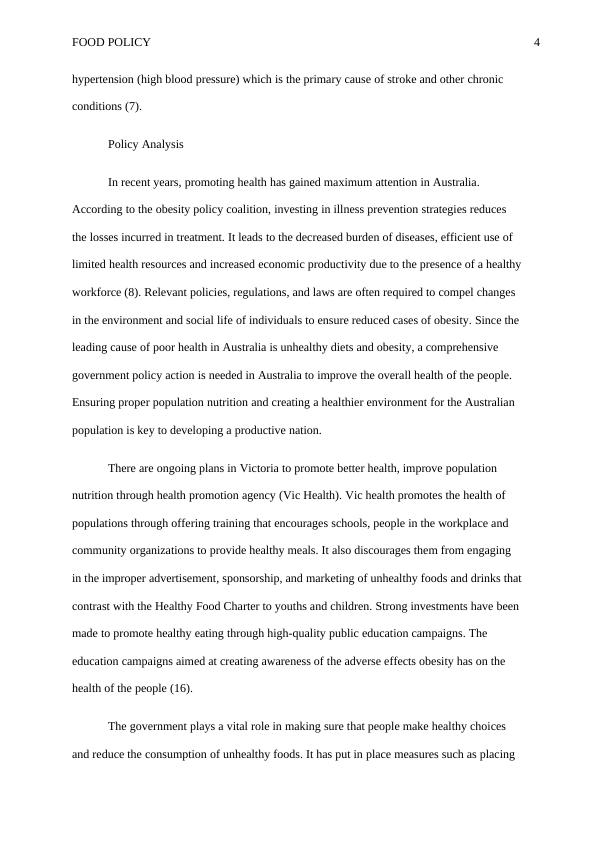Food Policy Assignment PDF
Added on 2021-05-31
11 Pages2812 Words26 Views
Running head: FOOD POLICY 1
Food Policy and Regulation
Name: Elvi Edelia Teresa
2000 words
Food Policy and Regulation
Name: Elvi Edelia Teresa
2000 words

FOOD POLICY 2
Inflammation risk: the importance of food labels in reducing obesity prevalence.
Rising cases of obesity have become a public health concern in every industrialized
country in the recent years. Obesity is a severe, chronic disease that can have adverse effects
on body systems. It increases an individual’s risk of developing non-communicable and
chronic diseases such as cardiovascular diseases and some types of cancer (1). It also exposes
individuals to various infections and inflammation. Individuals are required to reduce weight
to reduce the risk of developing these conditions. The rate of obesity has tripled in Australia
in the last three decades with two out of three adults (63%) and one in four children aged 5 to
17 years having the condition with a Body Mass Index of 30 and above.
The cost of treating obesity is estimated at $56 billion annually in Australia (2). The
primary cause of obesity is engaging in unhealthy and unbalance eating with lack of physical
activity. Some medical conditions such as Cushing’s syndrome and hypothyroidism may also
result to obesity. Some genetic factors such as increased appetite may be inherited from
parents and hence making it difficult to lose weight. Policy makers and health professionals
have put into place policies that may help reduce the occurrence of the condition. They can
achieve this if more emphasis is made on the importance of reading food labels.
The scope of the Problem
Having weight problems is a major concern for Australians. According to the 2014,15
Australian Health Survey, around 11.2 million people (63.4%) aged over 18 were overweight
or obese The overall results indicate that men and women have the percentage ratio of 70.8%
and 56.3% respectively. It is also clear that obesity increases with age. 79.4% and 65.7% of
men and women aged 45 years and above were overweight (3, 4). This problem can be solved
by encouraging individuals to practice healthy lifestyles and consume healthy foods from
Inflammation risk: the importance of food labels in reducing obesity prevalence.
Rising cases of obesity have become a public health concern in every industrialized
country in the recent years. Obesity is a severe, chronic disease that can have adverse effects
on body systems. It increases an individual’s risk of developing non-communicable and
chronic diseases such as cardiovascular diseases and some types of cancer (1). It also exposes
individuals to various infections and inflammation. Individuals are required to reduce weight
to reduce the risk of developing these conditions. The rate of obesity has tripled in Australia
in the last three decades with two out of three adults (63%) and one in four children aged 5 to
17 years having the condition with a Body Mass Index of 30 and above.
The cost of treating obesity is estimated at $56 billion annually in Australia (2). The
primary cause of obesity is engaging in unhealthy and unbalance eating with lack of physical
activity. Some medical conditions such as Cushing’s syndrome and hypothyroidism may also
result to obesity. Some genetic factors such as increased appetite may be inherited from
parents and hence making it difficult to lose weight. Policy makers and health professionals
have put into place policies that may help reduce the occurrence of the condition. They can
achieve this if more emphasis is made on the importance of reading food labels.
The scope of the Problem
Having weight problems is a major concern for Australians. According to the 2014,15
Australian Health Survey, around 11.2 million people (63.4%) aged over 18 were overweight
or obese The overall results indicate that men and women have the percentage ratio of 70.8%
and 56.3% respectively. It is also clear that obesity increases with age. 79.4% and 65.7% of
men and women aged 45 years and above were overweight (3, 4). This problem can be solved
by encouraging individuals to practice healthy lifestyles and consume healthy foods from

FOOD POLICY 3
early childhood to adulthood. Reducing too much sugar intake from soft drinks, sweet foods
and decreasing the portion of food one eats can also help fight obesity.
Reducing physical activity helps in reducing weight by burning excess calories in the
body and hence reducing the amount of both waist and total fat. Cases of obesity have also
risen in children. Research demonstrates that children with obesity are more likely to remain
the same while transitioning into adulthood. Teens from poor socio-economic backgrounds
are also at risk of having the condition. Exposure to obesity increases their risk of developing
noncommunicable diseases such as cardiovascular diseases at a young age. It also results in
the low quality of life and poor academic performance. It may also lead to early deaths as a
result of the diseases (4).
Effects of Obesity
Obesity poses various kinds of health effects on individuals. The threats it poses affect
the physical, psychological, emotional well-being and self-esteem of a person (4). Obesity is
a pro-inflammatory state and increases inflammation which may link to depression. The
social effects of obesity include low wages, discrimination of the poor, reduced quality of life
and increased susceptibility to depression. Obese teens have higher possibilities of
developing mental health problems such as anxiety, depression and poor self-esteem (5).
There is a strong association between socioeconomic status and obesity.
Females are at a higher risk of contracting the disease. Research states that hormones
play a crucial role in metabolism and maintaining optimal health. Changes in hormone levels
in women throughout their life predispose them to weight gain. Obesity triggers and increase
many co-morbidities like coronary artery disease (CAD) and type 2 diabetes (T2D) (6).
Childhood obesity can add up health problems and often in adults it will increase the risk of
contracting heart disease, developing type 2 diabetes (high blood sugar), certain cancers and
early childhood to adulthood. Reducing too much sugar intake from soft drinks, sweet foods
and decreasing the portion of food one eats can also help fight obesity.
Reducing physical activity helps in reducing weight by burning excess calories in the
body and hence reducing the amount of both waist and total fat. Cases of obesity have also
risen in children. Research demonstrates that children with obesity are more likely to remain
the same while transitioning into adulthood. Teens from poor socio-economic backgrounds
are also at risk of having the condition. Exposure to obesity increases their risk of developing
noncommunicable diseases such as cardiovascular diseases at a young age. It also results in
the low quality of life and poor academic performance. It may also lead to early deaths as a
result of the diseases (4).
Effects of Obesity
Obesity poses various kinds of health effects on individuals. The threats it poses affect
the physical, psychological, emotional well-being and self-esteem of a person (4). Obesity is
a pro-inflammatory state and increases inflammation which may link to depression. The
social effects of obesity include low wages, discrimination of the poor, reduced quality of life
and increased susceptibility to depression. Obese teens have higher possibilities of
developing mental health problems such as anxiety, depression and poor self-esteem (5).
There is a strong association between socioeconomic status and obesity.
Females are at a higher risk of contracting the disease. Research states that hormones
play a crucial role in metabolism and maintaining optimal health. Changes in hormone levels
in women throughout their life predispose them to weight gain. Obesity triggers and increase
many co-morbidities like coronary artery disease (CAD) and type 2 diabetes (T2D) (6).
Childhood obesity can add up health problems and often in adults it will increase the risk of
contracting heart disease, developing type 2 diabetes (high blood sugar), certain cancers and

FOOD POLICY 4
hypertension (high blood pressure) which is the primary cause of stroke and other chronic
conditions (7).
Policy Analysis
In recent years, promoting health has gained maximum attention in Australia.
According to the obesity policy coalition, investing in illness prevention strategies reduces
the losses incurred in treatment. It leads to the decreased burden of diseases, efficient use of
limited health resources and increased economic productivity due to the presence of a healthy
workforce (8). Relevant policies, regulations, and laws are often required to compel changes
in the environment and social life of individuals to ensure reduced cases of obesity. Since the
leading cause of poor health in Australia is unhealthy diets and obesity, a comprehensive
government policy action is needed in Australia to improve the overall health of the people.
Ensuring proper population nutrition and creating a healthier environment for the Australian
population is key to developing a productive nation.
There are ongoing plans in Victoria to promote better health, improve population
nutrition through health promotion agency (Vic Health). Vic health promotes the health of
populations through offering training that encourages schools, people in the workplace and
community organizations to provide healthy meals. It also discourages them from engaging
in the improper advertisement, sponsorship, and marketing of unhealthy foods and drinks that
contrast with the Healthy Food Charter to youths and children. Strong investments have been
made to promote healthy eating through high-quality public education campaigns. The
education campaigns aimed at creating awareness of the adverse effects obesity has on the
health of the people (16).
The government plays a vital role in making sure that people make healthy choices
and reduce the consumption of unhealthy foods. It has put in place measures such as placing
hypertension (high blood pressure) which is the primary cause of stroke and other chronic
conditions (7).
Policy Analysis
In recent years, promoting health has gained maximum attention in Australia.
According to the obesity policy coalition, investing in illness prevention strategies reduces
the losses incurred in treatment. It leads to the decreased burden of diseases, efficient use of
limited health resources and increased economic productivity due to the presence of a healthy
workforce (8). Relevant policies, regulations, and laws are often required to compel changes
in the environment and social life of individuals to ensure reduced cases of obesity. Since the
leading cause of poor health in Australia is unhealthy diets and obesity, a comprehensive
government policy action is needed in Australia to improve the overall health of the people.
Ensuring proper population nutrition and creating a healthier environment for the Australian
population is key to developing a productive nation.
There are ongoing plans in Victoria to promote better health, improve population
nutrition through health promotion agency (Vic Health). Vic health promotes the health of
populations through offering training that encourages schools, people in the workplace and
community organizations to provide healthy meals. It also discourages them from engaging
in the improper advertisement, sponsorship, and marketing of unhealthy foods and drinks that
contrast with the Healthy Food Charter to youths and children. Strong investments have been
made to promote healthy eating through high-quality public education campaigns. The
education campaigns aimed at creating awareness of the adverse effects obesity has on the
health of the people (16).
The government plays a vital role in making sure that people make healthy choices
and reduce the consumption of unhealthy foods. It has put in place measures such as placing

End of preview
Want to access all the pages? Upload your documents or become a member.
Related Documents
Childhood Obesity: Causes, Consequences and Prevention Strategieslg...
|6
|1570
|206
Go4Fun Health Program for Childhood Obesity in NSWlg...
|13
|3160
|312
Childhood Obesity Facts & Statisticslg...
|4
|2365
|478
Childhood Obesitylg...
|10
|2441
|70
Promoting Nutrition in Schools: Evidence-Based Strategies and Program Planlg...
|12
|3016
|256
Assignment on Childhood Obesity in Queenslandlg...
|1
|2109
|20
